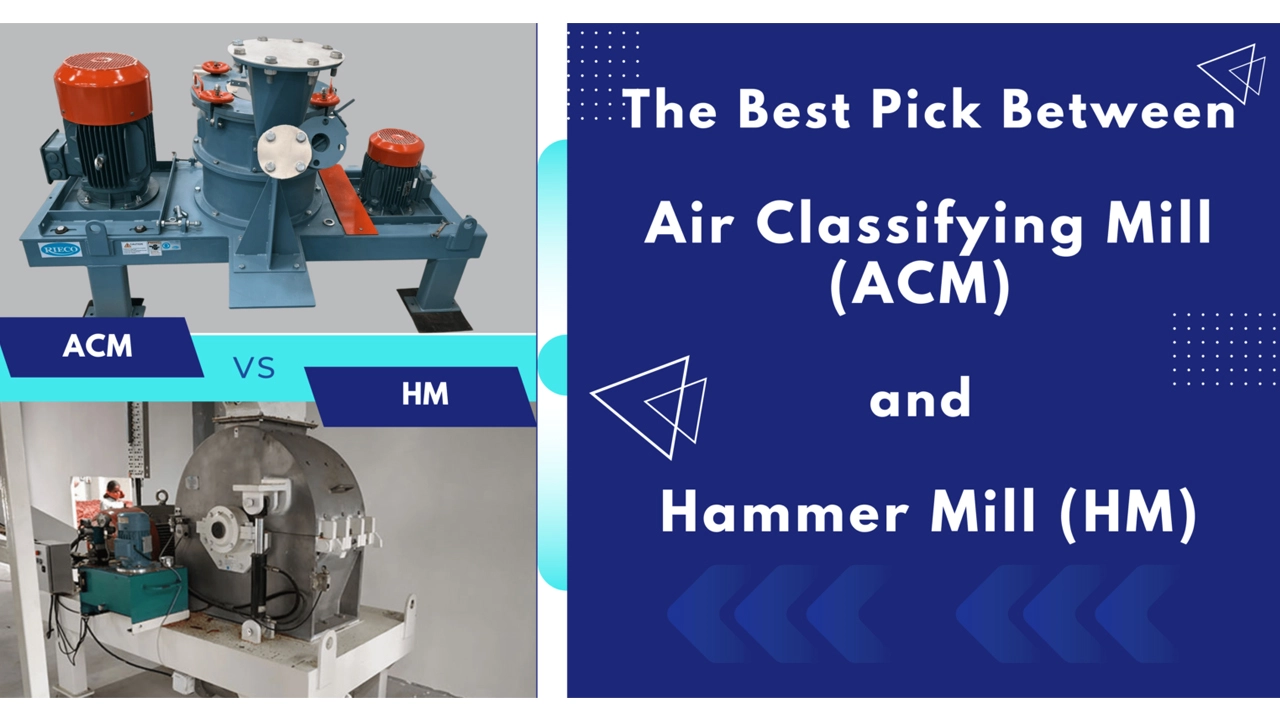- Industries
- Solutions
- Products
- Our Company
- Knowledge
- Contact Us

The Best Pick between Air Classifying Mill and Hammer Mill

Size reduction is an important unit operation in the chemical, power, mineral, metallurgical and pharmaceutical industries. There are a couple of sources that explain the fundamentals of material size reduction, but a few teach about the selection and size the right type of mill, operating mill efficiently, and maintaining it. There are numerous types of grinding mills. This article throws light on two widely used types: the hammer mill and the air classifying mill (ACM). Hammer mills are often used for general-purpose grinding and the finished product particle size that ranges from millimeters to tens of microns. The ACM is primarily used for superfine grinding applications and creates uniform particles size distribution down to a few microns. Understanding the fundamentals of each mill’s respective grinding mechanisms, operating philosophies, will help us in comparing the two.


| ACM | HAMMER MILL |
|---|---|
| Air classifier Mill (ACM) is an integrated grinding, classifying, conveying, and collecting operations for achieving ultra-fine grinding (of up to 2 micron*) depending upon the nature of the product. | Hammer Mill is designed for grinding by impact action, sieving, and collecting various materials. It comes with the provision for collection of the material either at the bottom by virtue of gravity or by Pulsaire Jet Product Collector with dust free operation. |
| The grinding occurs when the product meets a pin or bar type rotor disc. This reduced particles are entrained by the Air stream which enters below the rotor and are carried up between the inner wall and shroud ring with baffles, gets deflected by an air dispersion ring to the separator assembly. Acceptable product is collected by a high efficiency bag filter. Oversized particles are carried to Rotor for additional grinding. | Hammer mills consist of series of hammers (usually four or more) hinged on a central shaft and enclosed within a rigid metal case. It produces size reduction by impact. The materials to be grounded is struck by the hammers or beaters rotating at high speed inside the grinding chamber. |
| Air classifier Mill (ACM) can be designed for grinding hygroscopic, heat sensitive and explosive materials in inert gas/ closed loop systems with dry chilled air. | Hammer Mill is designed for grinding free flowing, non-hygroscopic, non-heat sensitive and explosive materials to produce consistent particle size distribution. |
Comparing any machine depends on the following parameters:

The Air Classifying Mill (ACM) has a flexible design capability. It can be personalized to meet the demands of individual applications. The design of the ACM offers temperature-controlled grinding, inert milling, and cryogenic milling. The Clam-Shell body design of the ACM provides an effortless entrance to the grinding chamber. They have pipe connections that are pressure-resistant and also have disposable mill liners, classifier wheels and grinding pins, bars, and hammers.
On the other hand, the hammer mills have variable hammers which produce fine finished products. The shaft speed is also one of the primary aspects of the design of the hammer mill. The drive is designed to equip a frequency converter to regulate the speed of the machine. Hammer mills have rotating hammers to access foreign bodies like metal particles.
In the Air Classifying Mill, you can put the product into the grinding section with the help of a feed screw or a pneumatic conveying system through a rotary feed valve. Then, the product is broken down and forced to the wall of the grinding section. The broken products move to the internal classifier that rotates in alignment with the rotor disc. The particles are processed continuously until all the particles move through the classifier wheel. It is then collected in a cyclone for further use.
The operation of the Hammer Mill, on the contrary, is not very complicated. The material is put into a feeding hopper and moved to the crushing chamber. The crushing chamber contains several knives and hammers that eliminate the size of the materials. This process is repeated multiple times to achieve the desired results. The materials are then filtered out through the output milling chamber.
ACM requires Cyclone & Bag-filter and fan arrangement along with compressed air for its application whereas that is not the case with standalone Hammer mills.
The Air Classifying Mill uses centrifugal force to break and move the materials into the grinding chamber. The induced airflow surrounding the exterior wall of the internal baffle assembly foliates the airflow to push the particles ahead. Therefore, the grinding mechanism of centrifugal force continues until the material breaks down into small particles.
The grinding mechanism of the hammer mill is relatively straightforward. It contains a steel drum that has a horizontal or vertical rotating shaft on which the hammers are ascended. The hammers swing freely on either end or fixed to the central rotor. The materials get crushed by the hammers attached and then extracted out through metal screens.
In ACM particle size can be controlled with classifier whereas in hammer mills the output screen decides the final size.
The design of the Air Classifying Mill allows quick and minimal maintenance. To clean, replace or maintain the Air Classifying Mill, you can easily remove the individual components of the mill like the classifier, the liner plate, the shroud ring, and the rotor plate. Moreover, the hinged top nuts and fly nuts are also detachable, thus making the maintenance procedure more effortless.
Hammer mills, on the other hand, require routine maintenance. The parts of the hammer mill like screens, pins and hammers should be replaced regularly. Moreover, flow directors, wear liners, regrind chambers, screen carriage, bearings, and couplings are some of the long-term maintenance items.
Several parameters need to be checked before selecting the mill. The most crucial things that you must keep in mind are the required annual capacity, whether you need continuous or batch operations, and which upstream and downstream processes will be required for the mill. A complete categorization of the feed material is necessary to identify the right mill for the job.
If your application is limited to just grinding material to a required fineness and the material you will be using is non-hygroscopic, not an explosive or heat generating type then its best to go with Hammer mill.
If you are looking for future trend and going to work with different materials which would require different fineness and material characteristic can be hygroscopic, heat sensitive or explosive then its best to have a versatile mill like ACM in your factory.

